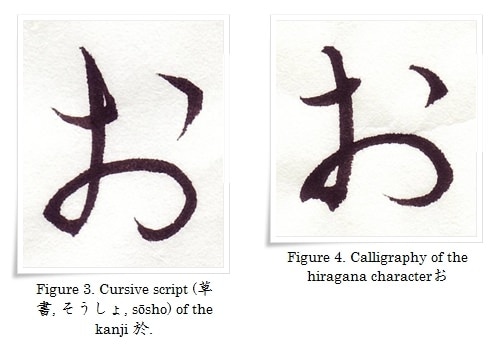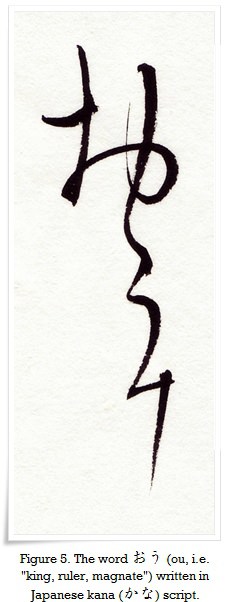The modern form of お comes from the cursive form of the kanji 於 (お, o, i.e. “at, in, on, as for”). Follow the progression of the different scripts shown in Figures 1 to 3 to understand its origin.
Figure 1. Standard script (楷書, かいしょ, kaisho) of the kanji 於. Calligraphy by 品天龍涙 (ぽんてりゅうるい, Ponte Ryūrui), ink on paper.
Figure 2. Semi-cursive script (行書, ぎょうしょ, gyōsho) of the kanji 於. Calligraphy by 品天龍涙 (ぽんてりゅうるい, Ponte Ryūrui), ink on paper.
Figure 3. Cursive script (草書, そうしょ, sōsho) of the kanji 於. Calligraphy by 品天龍涙 (ぽんてりゅうるい, Ponte Ryūrui), ink on paper.
Figure 4. Calligraphy of the hiragana character お. Note that in case of 於, the Cursive script form is virtually identical with that of hiragana character お. Calligraphy by 品天龍涙 (ぽんてりゅうるい, Ponte Ryūrui), ink on paper.
Figure 5. The word おう (ou, i.e. “king, ruler, magnate”) written in Japanese kana script (かな). The hiragana character う is based on the cursive form of the kanji 宇 (う, u, i.e. “counter for buildings”), which was explained in our previous article (note: it is one of many variants of character う which are often used in kana script, and its standardised hiragana version, commonly known today). Calligraphy by 品天龍涙 (ぽんてりゅうるい, Ponte Ryūrui), ink on paper.



